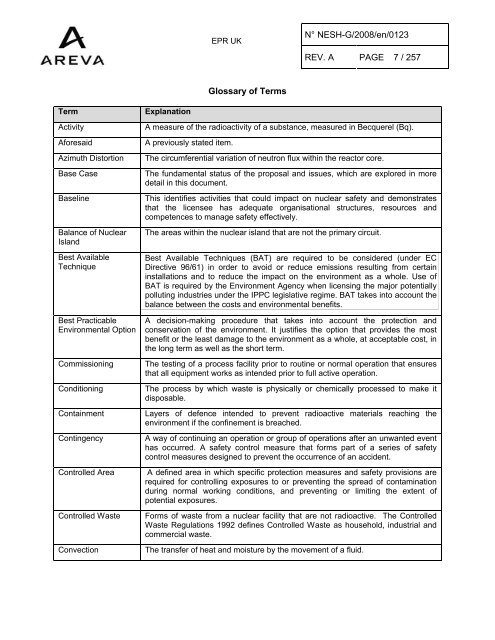Solid Radioactive Waste Strategy Report.pdf - UK EPR
Solid Radioactive Waste Strategy Report.pdf - UK EPR
Solid Radioactive Waste Strategy Report.pdf - UK EPR
You also want an ePaper? Increase the reach of your titles
YUMPU automatically turns print PDFs into web optimized ePapers that Google loves.
<strong>EPR</strong> <strong>UK</strong><br />
N° NESH-G/2008/en/0123<br />
REV. A PAGE 7 / 257<br />
Glossary of Terms<br />
Term<br />
Activity<br />
Aforesaid<br />
Azimuth Distortion<br />
Base Case<br />
Baseline<br />
Balance of Nuclear<br />
Island<br />
Best Available<br />
Technique<br />
Best Practicable<br />
Environmental Option<br />
Commissioning<br />
Conditioning<br />
Containment<br />
Contingency<br />
Controlled Area<br />
Controlled <strong>Waste</strong><br />
Convection<br />
Explanation<br />
A measure of the radioactivity of a substance, measured in Becquerel (Bq).<br />
A previously stated item.<br />
The circumferential variation of neutron flux within the reactor core.<br />
The fundamental status of the proposal and issues, which are explored in more<br />
detail in this document.<br />
This identifies activities that could impact on nuclear safety and demonstrates<br />
that the licensee has adequate organisational structures, resources and<br />
competences to manage safety effectively.<br />
The areas within the nuclear island that are not the primary circuit.<br />
Best Available Techniques (BAT) are required to be considered (under EC<br />
Directive 96/61) in order to avoid or reduce emissions resulting from certain<br />
installations and to reduce the impact on the environment as a whole. Use of<br />
BAT is required by the Environment Agency when licensing the major potentially<br />
polluting industries under the IPPC legislative regime. BAT takes into account the<br />
balance between the costs and environmental benefits.<br />
A decision-making procedure that takes into account the protection and<br />
conservation of the environment. It justifies the option that provides the most<br />
benefit or the least damage to the environment as a whole, at acceptable cost, in<br />
the long term as well as the short term.<br />
The testing of a process facility prior to routine or normal operation that ensures<br />
that all equipment works as intended prior to full active operation.<br />
The process by which waste is physically or chemically processed to make it<br />
disposable.<br />
Layers of defence intended to prevent radioactive materials reaching the<br />
environment if the confinement is breached.<br />
A way of continuing an operation or group of operations after an unwanted event<br />
has occurred. A safety control measure that forms part of a series of safety<br />
control measures designed to prevent the occurrence of an accident.<br />
A defined area in which specific protection measures and safety provisions are<br />
required for controlling exposures to or preventing the spread of contamination<br />
during normal working conditions, and preventing or limiting the extent of<br />
potential exposures.<br />
Forms of waste from a nuclear facility that are not radioactive. The Controlled<br />
<strong>Waste</strong> Regulations 1992 defines Controlled <strong>Waste</strong> as household, industrial and<br />
commercial waste.<br />
The transfer of heat and moisture by the movement of a fluid.

















